
- •Preface to the Second Edition
- •Preface to the First Edition
- •Contents
- •Contributors
- •Compositional Analysis of Naphtha and Reformate
- •Basic Reactions of Reforming on Metal Catalysts
- •Chemistry of Bifunctional Metal–Acid Catalysis
- •Naphtha Hydrotreatment
- •Preparation of Reforming Catalysts
- •Optimization of Catalyst Pore Structure by Kinetics and Diffusion Analysis
- •Naphtha Reforming Over Zeolite-Hybrid-Type Catalysts
- •Deactivation by Coking
- •Catalyst Regeneration and Continuous Reforming Issues
- •Precious Metals Recovery from Spent Reforming Catalysts
- •Licensed Reforming Processes
- •Control Systems for Commercial Reformers
- •Modeling Catalytic Naphtha Reforming
- •Index
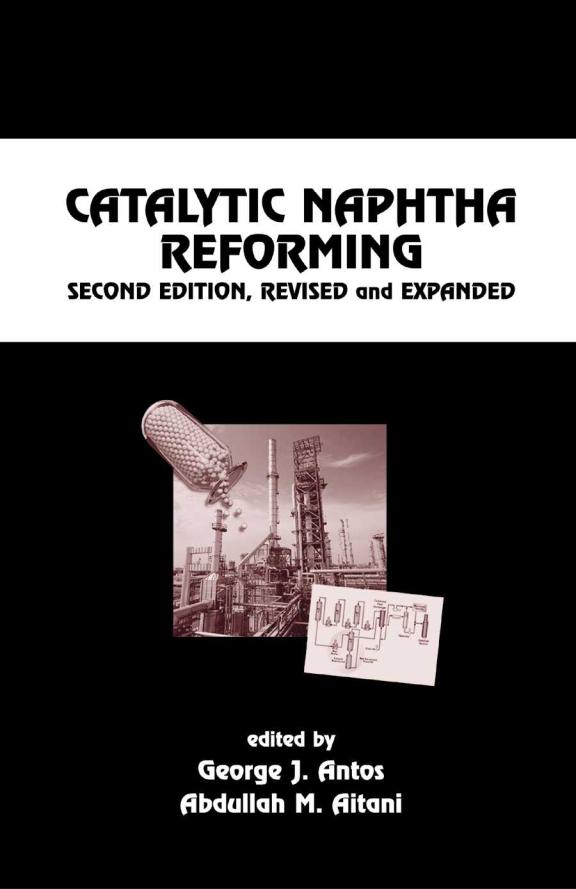
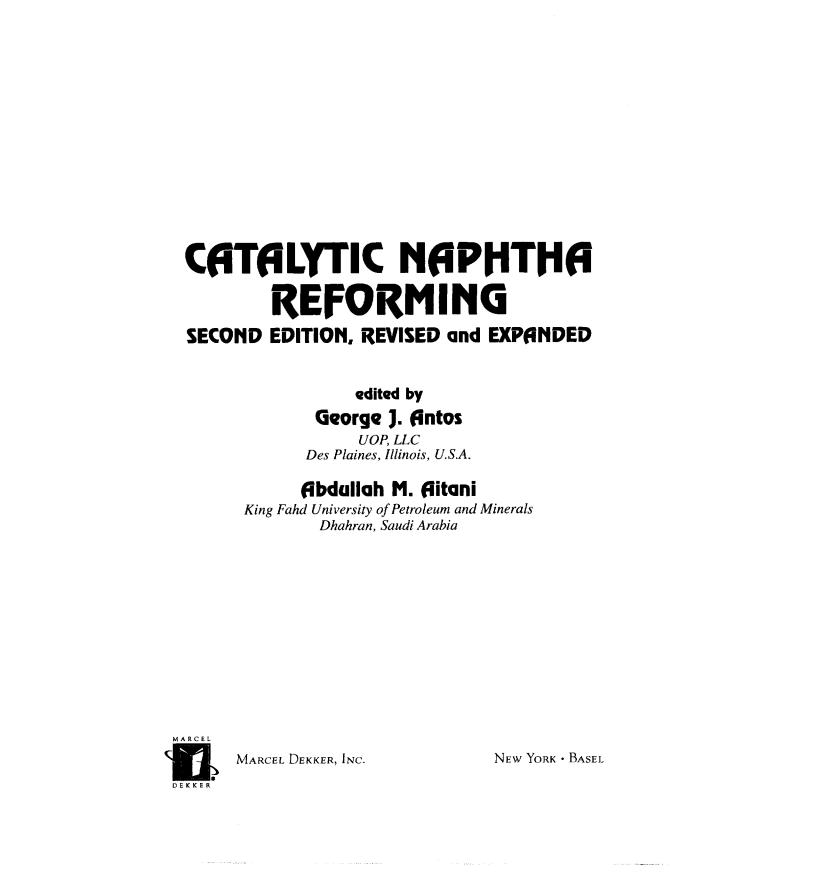
The first edition of this book was published as Catalytic Naphtha Reforming: Science and Technology, edited by George J. Antos, Abdullah M. Aitani, and Jose´ M. Parera (Marcel Dekker, Inc., 1995).
Although great care has been taken to provide accurate and current information, neither the author(s) nor the publisher, nor anyone else associated with this publication, shall be liable for any loss, damage, or liability directly or indirectly caused or alleged to be caused by this book. The material contained herein is not intended to provide specific advice or recommendations for any specific situation.
Trademark notice: Product or corporate names may be trademarks or registered trademarks and are used only for identification and explanation without intent to infringe.
Library of Congress Cataloging-in-Publication Data
A catalog record for this book is available from the Library of Congress.
ISBN: 0-8247-5058-6
This book is printed on acid-free paper.
Headquarters
Marcel Dekker, Inc., 270 Madison Avenue, New York, NY 10016, U.S.A. tel: 212-696-9000; fax: 212-685-4540
Distribution and Customer Service
Marcel Dekker, Inc., Cimarron Road, Monticello, New York 12701, U.S.A. tel: 800-228-1160; fax: 845-796-1772
Eastern Hemisphere Distribution
Marcel Dekker AG, Hutgasse 4, Postfach 812, CH-4001 Basel, Switzerland tel: 41-61-260-6300; fax: 41-61-260-6333
World Wide Web
http://www.dekker.com
The publisher offers discounts on this book when ordered in bulk quantities. For more information, write to Special Sales=Professional Marketing at the headquarters address above.
Copyright # 2004 by Marcel Dekker, Inc. All Rights Reserved.
Neither this book nor any part may be reproduced or transmitted in any form or by any means, electronic or mechanical, including photocopying, microfilming, and recording, or by any information storage and retrieval system, without permission in writing from the publisher.
Current printing (last digit): 10 9 8 7 6 5 4 3 2 1
PRINTED IN THE UNITED STATES OF AMERICA
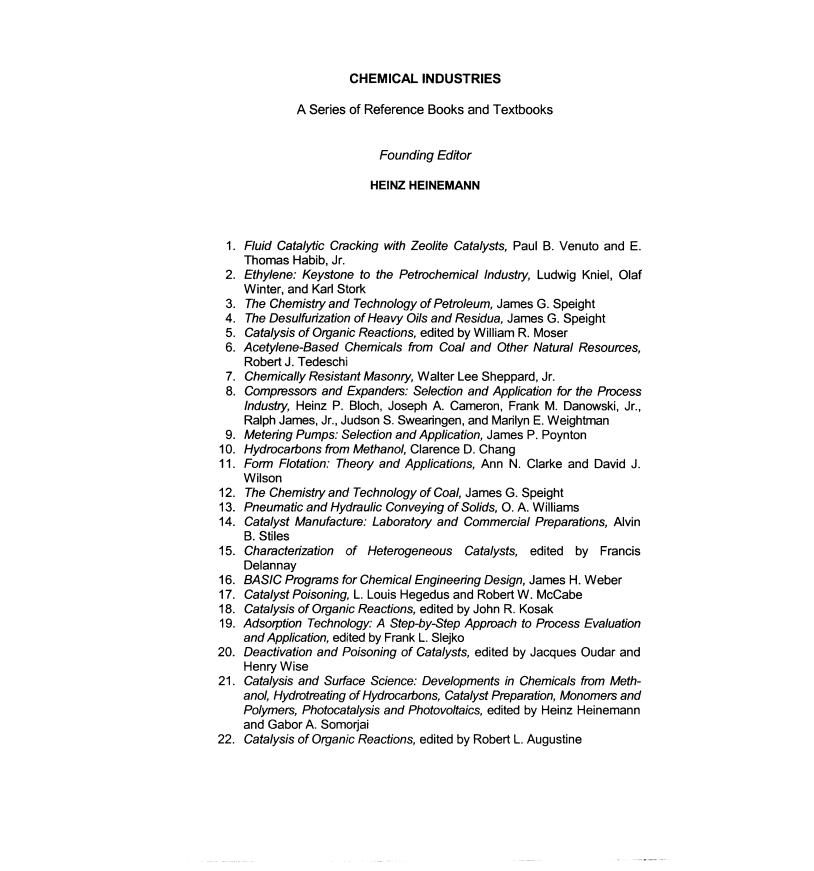
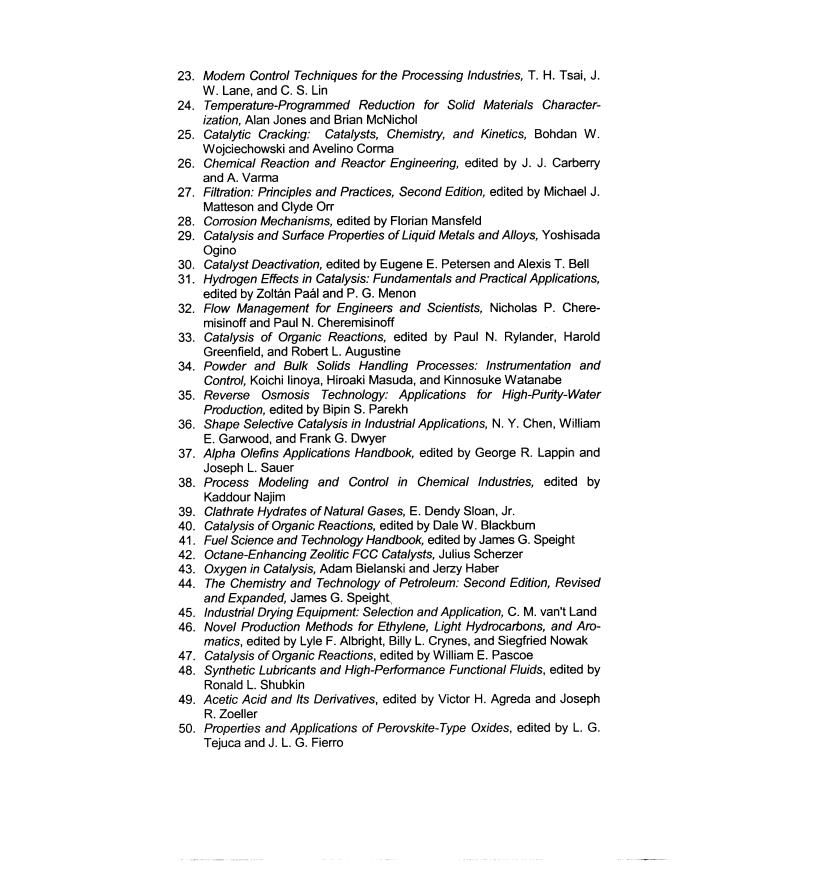
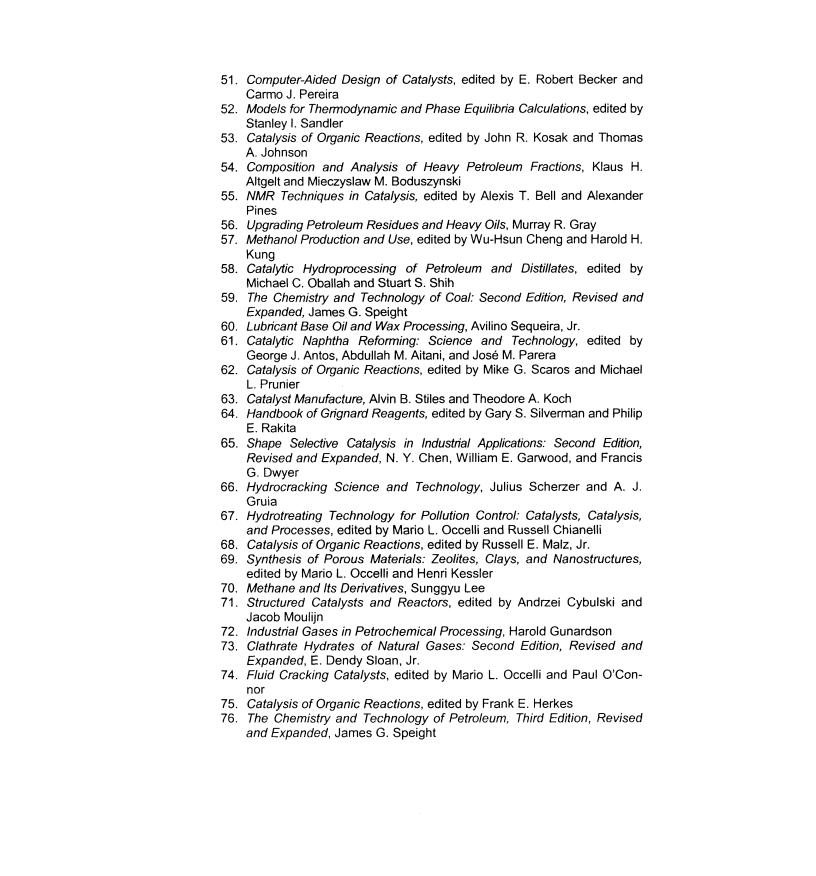
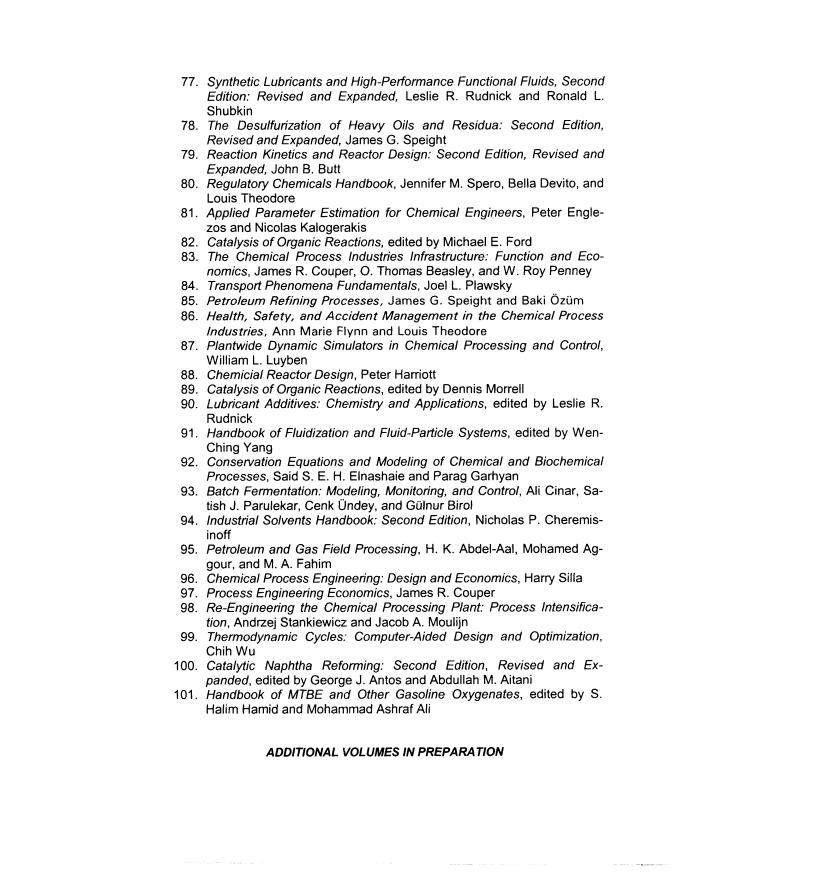
Preface to the Second Edition
Nearly a decade has passed since the publication of the first edition of Catalytic Naphtha Reforming. That book was a survey of the technology encompassing the first 45 years of the use of this process in the refining industry. In preparing the second edition, perspective on this refining process was again considered. It is still true that catalytic reforming is the primary process in the refinery for producing high-octane gasoline to be blended into the gasoline pool. As needs for gasoline have risen, the demands on the reformer have also increased. What has changed is that additional drivers have surfaced, which have added to the demands on the process.
The first of these demands are the new environment-based regulations for fuel quality parameters. In particular, the targeted reduced-sulfur content for gasoline and diesel fuel has had an impact on the catalytic reformer. Although sulfur in the gasoline pool does not originate with the reformer, sulfur content of naphtha from the fluid catalytic cracker does require significant treatment in order to continue inclusion in the pool. Most of the schemes to deal with this sulfur involve some level of hydrodesulfurization. Hydrogen is required, and the reformer is one of the few units to provide hydrogen in the refinery. The result is an increased demand on the catalytic reformer. Although many of these hydrotreating schemes attempt to minimize octane loss, any loss will need to be countered with more output from the octane machine—the reformer. Environmental regulations aimed at lowering sulfur in diesel fuel also increase the need for hydrogen in the refinery. Hydrogen demand has increased overall in the refinery, and the catalytic reformer is under pressure to produce more hydrogen by an increased severity of operation or by improved selectivity to aromatics.
In addition, in the United States, the drive to eliminate the use of MTBE as an oxygenate component in the gasoline pool will impact the reformer situation. Octane barrels are lost when MTBE is replaced by ethanol. The catalytic reformer will need to replace these lost octane barrels, largely through an increased severity of operation or through higher yields of high octane.
Over the past decade, refiners have been forced to maximize their existing asset utilization. With capital at a premium, refiners must deliver more from the units they already have. These twin pressures from environmental regulations and
iii
iv |
Preface to the Second Edition |
asset utilization have impacted the catalytic reformer. New technology, in the form of new catalysts or a minimal revamp of process improvements, was required. The catalyst vendors and process licensors have responded to these needs, thereby fulfilling predictions in the first edition and providing the basis for this book.
For this edition, prominent authors were again invited to either update an existing chapter or write a new chapter. The layout of the book is logical and similar to that of the first edition. Part I covers the chemistry of naphtha reforming, emphasizing basic reforming reactions, metal/acid catalysis, and naphtha hydrotreatment. Part II is a detailed review of reforming catalysts. The chapter on catalyst preparation has been extensively enhanced with an in-depth treatment of platinum impregnation chemistry, a topic that has been extensively investigated over the past decade. When combined with the updated chapter on catalyst characterization, this section serves as a reference source for anyone involved in the preparation of or research on platinum-containing catalysts. Included in this section is a completely updated discussion of the commercial reforming catalysts available from vendors today. Two chapters that are more experimental have been included on the future direction of catalyst technology in pore structure optimization and zeolite-hybrid catalysts.
Part III focuses on catalyst deactivation by coking and regeneration. Added to this is a discussion on some of the issues that are important to continuous reformer operations involving catalyst movement and continuous regeneration as experienced by refinery personnel. A separate chapter is dedicated to the recovery of the precious metals from the reforming catalyst.
In Part IV, commercial process technology is covered. The licensed processes are reviewed in conjunction with chapters on control systems and modeling for commercial reformer units.
Once again it has been our pleasure to work with the contributors of this book. They paid much attention to reviewing the literature in the area, and then skillfully combined it with their own work and insights. It has been an extensive effort and has taken time to bring it to completion. We give special thanks to the contributors and the publisher for their patience. Our intent was to place our combined experience and knowledge of the technology of catalytic naphtha reforming into one book in order to share it with all those who need this information. We hope that this second edition will be recognized as a valuable resource for those involved in the reforming or related catalysis areas, whether as academics, graduate students, industrial researchers, chemical engineers, or refinery personnel. Knowledge and the time to gain it are two assets that we have attempted to help you manage to your advantage with this volume.
George J. Antos
Abdullah M. Aitani
Preface to the First Edition
The use of catalytic naphtha reforming as a process to produce high-octane gasoline is as important now as it has been for over the 45 years of its commercial use. The catalytic reformer occupies a key position in a refinery, providing high value-added reformate for the gasoline pool; hydrogen for feedstock improvement by the hydrogen-consuming hydrotreatment processes; and frequently benzene, toluene, and xylene aromatics for petrochemical uses. The technology has even further impact in the refinery complex. The processes of hydrogenation, dehydrogenation, and isomerization have all benefited from the catalyst, reactor, and feed treatment technologies invented for catalytic reforming processes. The longterm outlook for the reforming catalyst market remains strong. The conditions of operation of catalytic reforming units are harsh and there is an increasing need for reformate. Presently, the catalytic reforming process is currently operated to produce research octane numbers of 100 and more.
Since its introduction, catalytic reforming has been studied extensively in order to understand the catalytic chemistry of the process. The workhorse for this process is typically a catalyst composed of minor amounts of several components, including platinum supported on an oxide material such as alumina. This simplification masks the absolute beauty of the chemistry involved in combining these components in just the proper manner to yield a high-performance, modern reforming catalyst. The difficulty in mastering this chemistry and of characterizing the catalyst to know what has been wrought is the driving force behind the many industrial and academic studies in reforming catalysis available today.
Several questions come to mind. Why are scientists continuing to research this area of catalysis? What have all the preceding studies taught us about these catalysts, and what remains unknown? Given the numerous studies reported in the patent literature and in technical journals, it is surprising that a survey aimed at answering these questions summarizing the preceding experiences is not readily found. All the editors and contributors of this book are experienced in the study of reforming catalysts, and each one of them would have employed such a survey in his own research program. This volume provides information not currently available from one single literature source. The chapters are written by well-known authorities in the fields encompassed by catalytic reforming, starting
v
vi |
Preface to the First Edition |
with the process chemistry and focusing on the preparation, characterization, evaluation, and operation of the catalyst itself. The unknown aspects of catalyst chemistry and fundamental studies attempting to provide an understanding are also presented. Some attempt is made to predict the future for this catalyst technology, a task made complicated by the conflicting demand for more transportation fuels and petrochemicals, and the resolution to reduce the pollution resulting from their use.
It has been our pleasure to work with the contributors involved in this book. Their effort in combining their own research with the recent literature in the field of catalytic naphtha reforming is highly appreciated. This effort would not have been possible without their willingness to share valuable knowledge and experience. Moreover, we express our gratitude for their responsiveness to deadlines and review comments.
The editors hope that veteran industrial researchers will recognize this volume as an important resource and that novice researchers in the field of reforming and related catalysts—industrial chemists assigned to their first major catalysis project, graduate students embarking on the study of catalysis, and chemical engineers in the refinery responsible for full-scale commercial catalytic reforming—will find this a valuable reference volume and tool for their future endeavors in this exciting area.
George J. Antos
Abdullah M. Aitani
Jose´ M. Parera
